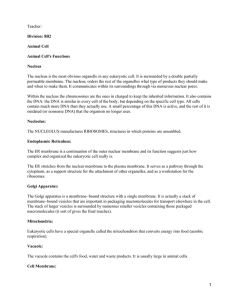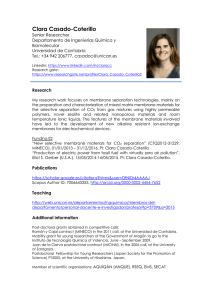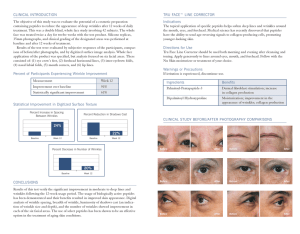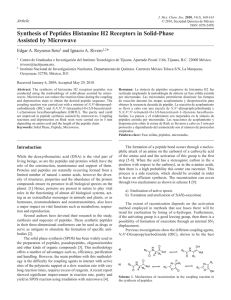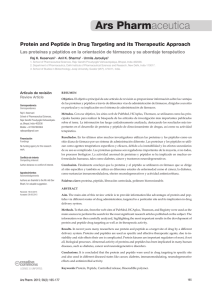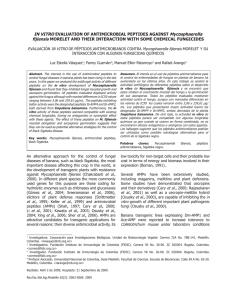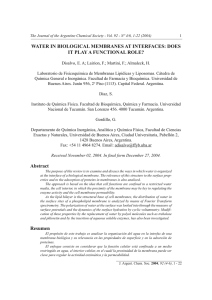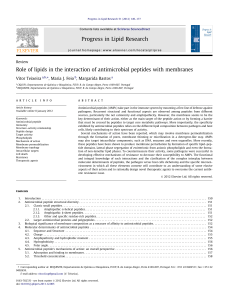Why and how are peptide-lipid interactions utilized for selfdefense (7)
Anuncio
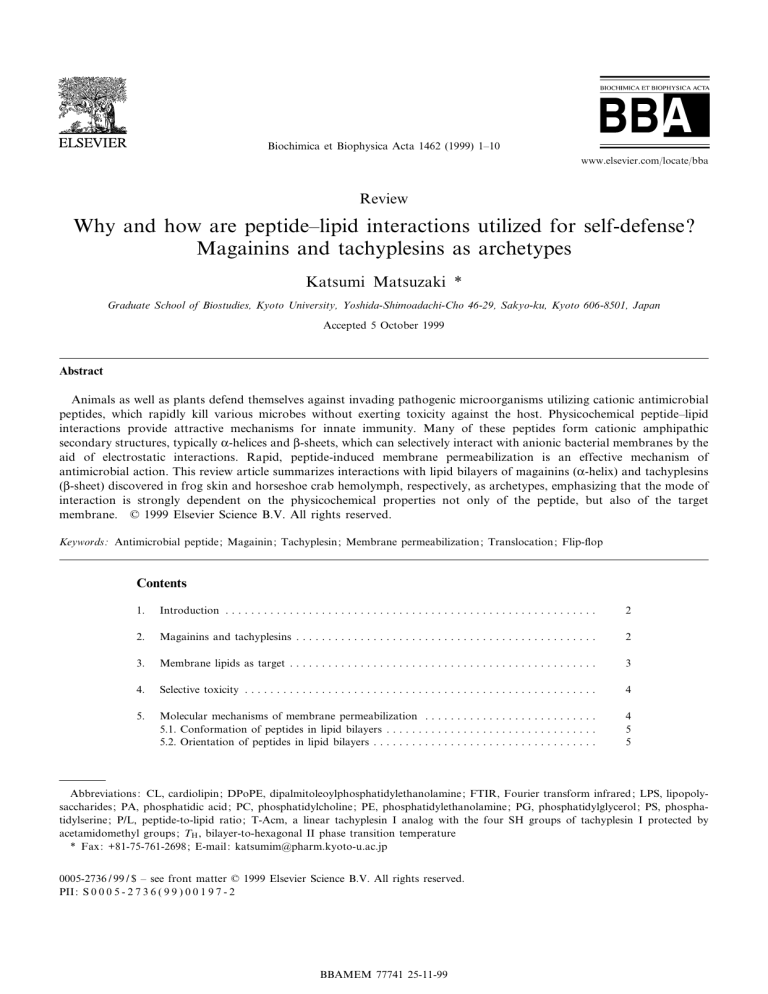
Biochimica et Biophysica Acta 1462 (1999) 1^10 www.elsevier.com/locate/bba Review Why and how are peptide^lipid interactions utilized for self-defense? Magainins and tachyplesins as archetypes Katsumi Matsuzaki * Graduate School of Biostudies, Kyoto University, Yoshida-Shimoadachi-Cho 46-29, Sakyo-ku, Kyoto 606-8501, Japan Accepted 5 October 1999 Abstract Animals as well as plants defend themselves against invading pathogenic microorganisms utilizing cationic antimicrobial peptides, which rapidly kill various microbes without exerting toxicity against the host. Physicochemical peptide^lipid interactions provide attractive mechanisms for innate immunity. Many of these peptides form cationic amphipathic secondary structures, typically K-helices and L-sheets, which can selectively interact with anionic bacterial membranes by the aid of electrostatic interactions. Rapid, peptide-induced membrane permeabilization is an effective mechanism of antimicrobial action. This review article summarizes interactions with lipid bilayers of magainins (K-helix) and tachyplesins (L-sheet) discovered in frog skin and horseshoe crab hemolymph, respectively, as archetypes, emphasizing that the mode of interaction is strongly dependent on the physicochemical properties not only of the peptide, but also of the target membrane. ß 1999 Elsevier Science B.V. All rights reserved. Keywords: Antimicrobial peptide; Magainin; Tachyplesin ; Membrane permeabilization; Translocation; Flip-£op Contents 1. Introduction . . . . . . . . . . . . . . . . . . . . . . . . . . . . . . . . . . . . . . . . . . . . . . . . . . . . . . . . . . 2 2. Magainins and tachyplesins . . . . . . . . . . . . . . . . . . . . . . . . . . . . . . . . . . . . . . . . . . . . . . . 2 3. Membrane lipids as target . . . . . . . . . . . . . . . . . . . . . . . . . . . . . . . . . . . . . . . . . . . . . . . . 3 4. Selective toxicity . . . . . . . . . . . . . . . . . . . . . . . . . . . . . . . . . . . . . . . . . . . . . . . . . . . . . . . 4 5. Molecular mechanisms of membrane permeabilization . . . . . . . . . . . . . . . . . . . . . . . . . . . 5.1. Conformation of peptides in lipid bilayers . . . . . . . . . . . . . . . . . . . . . . . . . . . . . . . . . 5.2. Orientation of peptides in lipid bilayers . . . . . . . . . . . . . . . . . . . . . . . . . . . . . . . . . . . 4 5 5 Abbreviations: CL, cardiolipin; DPoPE, dipalmitoleoylphosphatidylethanolamine ; FTIR, Fourier transform infrared ; LPS, lipopolysaccharides; PA, phosphatidic acid; PC, phosphatidylcholine; PE, phosphatidylethanolamine; PG, phosphatidylglycerol; PS, phosphatidylserine; P/L, peptide-to-lipid ratio; T-Acm, a linear tachyplesin I analog with the four SH groups of tachyplesin I protected by acetamidomethyl groups; TH , bilayer-to-hexagonal II phase transition temperature * Fax: +81-75-761-2698; E-mail: [email protected] 0005-2736 / 99 / $ ^ see front matter ß 1999 Elsevier Science B.V. All rights reserved. PII: S 0 0 0 5 - 2 7 3 6 ( 9 9 ) 0 0 1 9 7 - 2 BBAMEM 77741 25-11-99 2 K. Matsuzaki / Biochimica et Biophysica Acta 1462 (1999) 1^10 5.3. 5.4. 5.5. 5.6. . . . . 6 7 8 8 Concluding remarks . . . . . . . . . . . . . . . . . . . . . . . . . . . . . . . . . . . . . . . . . . . . . . . . . . . . 8 Acknowledgements . . . . . . . . . . . . . . . . . . . . . . . . . . . . . . . . . . . . . . . . . . . . . . . . . . . . . . . . . 9 References . . . . . . . . . . . . . . . . . . . . . . . . . . . . . . . . . . . . . . . . . . . . . . . . . . . . . . . . . . . . . . . 9 6. Peptide-induced curvature stress in membranes Translocation of peptides across lipid bilayers . Peptide^peptide association . . . . . . . . . . . . . . . Peptide^outer membrane interactions . . . . . . . . 1. Introduction During the last decade, a large number of antimicrobial peptides have been discovered from animals as well as plants [1^4]. These molecules, which are either constitutive or inducible, are recognized as important components of innate defense mechanisms and are present on mucosal surfaces, on the body surface, and within the granules of phagocytes. These peptides are typically composed of 12^45 amino acid residues. Table 1 summarizes several representative peptides. The following four features are required of the antimicrobial peptides as the ¢rst step of self-defense against invading pathogenic microorganisms (see Fig. 5). (1) Selective toxicity; the peptides should discriminate between host and microbial cells. (2) Fast killing; the time needed for bacterial killing should be much shorter than the doubling time of the target bacteria, which is 20 min in the case of Escherichia coli. (3) Broad antimicrobial spectra; desirably a single species of peptide is e¡ective against many species of microorganisms. (4) No resistance development; the peptide should have such a mechanism of action that the bacteria cannot easily develop resistance against it. For selective toxicity and broad spectra, the peptides should target those molecules which are ubiquitous in prokaryotic cells, but rarely or never present in eukaryotic cells. Development of resistance is considered to be di¤cult if the target molecules are important components conserved among microorganisms. For rapid killing, the site of action should preferably be the cell surface rather than the cell interior. To ful¢l these requirements, many of the self-defense peptides act on cytoplasmic membranes of microorganisms, which are functional analogs of the . . . . . . . . . . . . . . . . . . . . . . . . . . . . . . . . . . . . . . . . . . . . . . . . . . . . . . . . . . . . . . . . . . . . . . . . . . . . . . . . . . . . . . . . . . . . . . . . . . . . . . . . . . . . . . . . mitochondrial inner membranes of eukaryotic cells with cytochromes and other enzymes of the respiratory chain. The host utilizes physicochemical peptide^lipid interactions to permeabilize the membranes, as will be described in the following sections. However, it should be noted that some peptides have been suggested to exhibit bactericidal activity via mechanisms other than membrane permeabilization [5]. The membrane-acting peptides have common physicochemical properties; they are highly basic (cationic) due to the presence of multiple Lys and Arg residues and form amphipathic secondary structures (K-helix and L-sheet), which can be accommodated into membranes. In this paper, the interactions of magainins and tachyplesins with lipid bilayers and bacterial membranes will be reviewed as archetypes of K-helical and L-sheet peptides, respectively. Only key references and recent progress regarding magainins will be summarized to avoid overlap of the recent review on this topic [6]. It should be noted that protegrins from polymorphonuclear neutrophils show three-dimensional structures and membrane interactions similar to those of tachyplesins, although the primary structures are quite di¡erent from each other [7^10]. 2. Magainins and tachyplesins Magainins were discovered from the granular gland of the skin of the African clawed frog Xenopus laevis by Zaslo¡ in 1987 [11]. In the narrow sense, magainins denote two 23-residue peptides, magainins 1 and 2 (Table 1). However, the amidated forms of magainins and other related peptides such as PGLa of the same origin [12] have often been called `mag- BBAMEM 77741 25-11-99 K. Matsuzaki / Biochimica et Biophysica Acta 1462 (1999) 1^10 3 Table 1 Representative antimicrobial peptides a b Acidic and basic residues are underlined and shown in bold face, respectively. Tachyplesin I was also isolated from T. gigas and Carcinoscorpius rotundicauda. ainins'. Magainins exhibit a broad spectrum of antimicrobial activity against bacteria, fungi, and protozoa typically in the concentration range of 10^100 Wg/ml [3,11,13^16]. In contrast, more than 1 mg/ml is needed to lyse mammalian cells, e.g. erythrocytes [17]. That is, the peptides are selectively toxic against microorganisms. The tachyplesin family peptides were isolated from the hemocytes of horseshoe crabs. The yield was as high as tens of milligrams per 100 g wet weight of the tissue. Tachyplesin I was ¢rst found from Tachypleus tridentatus in 1988 [18]. Tachyplesins II and III and polyphemusins I and II from other species followed thereafter [19,20]. These molecules are composed of 17^18 amino acid residues and have unique primary structures that contain three tandem repeats of a tetrapeptide, hydrophobic amino acid-Cys-aromatic amino acid-Arg and an amidated C-terminus (Table 1). Methods of chemical synthesis have been established [21,22]. These peptides are more active than magainins with minimum inhibitory concentrations for bacteria and fungi in the range of 1^10 Wg/ml [3,16,18,19,23], whereas hemolysis becomes signi¢cant at 0.1 mg/ml [17,24]. 3. Membrane lipids as target These peptides are considered to kill bacteria by permeabilizing and/or disrupting bacterial membranes. Addition of magainin 2 [16] or tachyplesin I [24,25] to E. coli (Gram-negative) or Staphylococcus aureus (Gram-positive) cells induces the e¥ux of intracellular K ions and concomitant reduction in cell viability. The lethal event appears to be depolarization of the inner membranes, preceded by permeabilization of the outer membranes in the case of Gramnegative bacteria [16,26,27]. The fundamental architecture of biomembranes is the lipid bilayer, in which membrane proteins are BBAMEM 77741 25-11-99 4 K. Matsuzaki / Biochimica et Biophysica Acta 1462 (1999) 1^10 embedded in a mosaic fashion. Magainins, like other membrane-acting antimicrobial peptides, appear to target the lipid matrix rather than the proteins because enantiomeric peptides composed of D-amino acids exhibit the same potency as naturally occurring all-L peptides, indicating that chiral molecules are not involved in the antimicrobial action [15,28]. Indeed, magainins [29^33] and tachyplesins [25,34] induce permeabilization of arti¢cial lipid bilayers (vesicles and planar lipid bilayers). 4. Selective toxicity The most striking di¡erence in cytoplasmic membranes between prokaryotic and eukaryotic cells is the composition and topological arrangement of lipids [35]. The surface (outer lea£et) of mammalian cell membranes is exclusively composed of electrically neutral, zwitterionic phospholipids, mainly phosphatidylcholine (PC) and sphingomyelin, whereas bacterial membranes contain large amounts of negatively charged phospholipids, phosphatidylglycerol (PG) and cardiolipin (CL), although their asymmetric distribution between the two lea£ets is not well known (Fig. 1). The anionic lipids should be exposed to the outer lea£et to a signi¢cant extent because the acidic lipid contents sometimes exceed 50% [36]. The outer membranes of Gram-negative bacteria are covered with polyanionic lipopolysaccharides (LPS). The activity of magainins and tachyplesins is highly sensitive to the lipid composition of the target membrane. The lipid speci¢city can explain the selective toxicity [17,37]. These peptides selectively bind to and permeabilize anionic membranes [17,25,29^ 31,38]. The driving forces of binding are hydrophobic interactions between the non-polar amino acids and the hydrophobic core of the membrane, and electrostatic interactions between the positive charges of the peptides and the negative charges of the lipids. The hydrophobicities of the self-defense peptides are generally too low to e¡ectively associate with zwitterionic phospholipids, avoiding toxicity against the host. In contrast, those of venoms and toxins are relatively high [17]. For example, the binding constant of bee venom melittin to PC bilayers is 4.5U104 M31 [39], which is much greater than that of magainin 2 amide (55 M31 ) [40]. The large pos- Fig. 1. Molecular basis for membrane discrimination by antimicrobial peptides. Cationic peptides preferentially bind to bacterial membranes with abundant acidic phospholipids by the aid of electrostatic interactions. The outer lea£ets of mammalian cell membranes are exclusively composed of zwitterionic phospholipids, for which the peptides show only low a¤nity. The presence of cholesterol also contributes to the resistance of the membranes against the peptides. itive charges of the antimicrobial peptides enable selective binding to bacterial membranes through electrostatic interactions (Fig. 1). For example, the presence of a surface potential as small as 320 mV can enhance the apparent binding constant of tachyplesin I (7+) by approximately 200-fold at physiological temperature. The observation that magainins and tachyplesin I show higher antibacterial activity against bacteria with membranes containing larger amounts of acidic lipids also supports this hypothesis [16]. Another major di¡erence in chemical composition of membranes between prokaryotic and eukaryotic cells is that the latter are abundant in sterols, although some prokaryotes contain sterols or hepanoids, which are similar to sterols [41]. The presence of membrane-stabilizing cholesterol has been shown to protect human erythrocytes from attack by magainin 2 (Fig. 1) [17]. 5. Molecular mechanisms of membrane permeabilization As will be shown later in detail, peptide^lipid in- BBAMEM 77741 25-11-99 K. Matsuzaki / Biochimica et Biophysica Acta 1462 (1999) 1^10 5 teractions are time-dependent. Therefore the investigator should always bear in mind which state is being observed at any given time. The conformation and orientation of magainins and tachyplesins described here are considered to be those in an equilibrium or `quasi-equilibrium' state. ture is rigid except for the £exible N- and C-terminal tails. The Trp2 residue is fully accessible to an aqueous quencher, acrylamide (Stern^Volmer constant 8.7 M31 ) [25]. The peptide also assumes an antiparallel L-sheet conformation in acidic phospholipid bilayers as revealed by Fourier transform infrared (FTIR) spectroscopy [38]. The Trp residue in the membrane is completely shielded from the quencher and is located close to the interface [25]. Although tachyplesin I adopts an antiparallel L-sheet structure in both the aqueous and membrane phases, minor alterations of the peptide backbone and side chain orientations have been suggested to occur upon membrane binding [52,53]. A linear tachyplesin I analog (T-Acm), in which the four SH groups of tachyplesin I are protected by acetamidomethyl groups, also forms an antiparallel L-sheet in membranes [38]. The lower wavenumber (1620 cm31 ) of the amide I vibration compared with that of tachyplesin I (1630 cm31 ) suggests stronger interchain hydrogen bonding. T-Acm shows severalfold weaker antimicrobial activities compared with cyclic tachyplesin I [23]. 5.1. Conformation of peptides in lipid bilayers 5.2. Orientation of peptides in lipid bilayers In the hydrophobic environment of lipid bilayers where no hydrogen-bonding groups exist, antimicrobial peptides form intramolecular or intermolecular hydrogen bonds, folding into amphipathic secondary structures. Magainins including PGLa have little or no well-de¢ned secondary structure in aqueous solutions at neutral pH, whereas the peptides essentially assume K-helical structures (helicity 60^90%) upon binding to acidic phospholipid bilayers as revealed by circular dichroism [29,30,42^45], vibrational [46^ 48], and NMR spectroscopy [48,49]. As shown in Fig. 2, magainin 2 and PGLa can form ideal amphipathic helices with polar angles of V180³ and V100³, respectively. NMR studies showed that in contrast to magainins, tachyplesin I forms a cyclic antiparallel L-sheet connected by a type II L-turn even in aqueous solution because of the two disul¢de bridges (Fig. 3) [50,51]. The sheet is not perfectly amphipathic; the Arg5 ^Arg14 pair are aligned opposite to the Arg15 ^ Arg17 pair. This unique structure may be important for the peptide^LPS interaction [51]. The sheet struc- The lipid bilayer is composed of a hydrophilic polar head group region and a hydrophobic core, although recent studies have emphasized a more complicated nature of the interfacial region [54]. Am- Fig. 2. Helical wheel representation of magainin 2 and PGLa. The shaded area indicates the hydrophobic surfaces of the amphipathic helices. Fig. 3. The space ¢lling model of the solution structure of tachyplesin I [51]. The molecule is shown orthogonal to the mean plane of the L-sheet. The shaded atoms represent the side-chain nitrogens. BBAMEM 77741 25-11-99 6 K. Matsuzaki / Biochimica et Biophysica Acta 1462 (1999) 1^10 phipathic secondary structures can be accommodated in the membranes with the hydrophobic amino acid side chains embedded in the hydrocarbon core and the polar side chains interfacing with water. Therefore, the antimicrobial peptides essentially lie parallel to the membrane surface (Fig. 4). Solid-state NMR [49,55] and £uorescence quenching experiments [56] revealed that the helix lies parallel to the membrane surface. Analysis by FTIR-polarized attenuated total re£ection spectroscopy indicated that the sheet planes of tachyplesin I and T-Acm are also on the membrane surface [38]. It is also possible for the peptides to adopt a transmembrane orientation. In this case, to avoid unfavorable exposure of the polar residues to the lipid hydrocarbon chains, the peptides should self-aggregate, forming an aqueous pore in the center. The magainin 1 helix starts to be inserted perpendicular to the membrane surface above a peptide to lipid ratio (P/L) of 1/30 [57]. The parallel-to-perpendicular orientational transition is closely related to peptideinduced membrane perturbation, as will be described below. 5.3. Peptide-induced curvature stress in membranes The incorporation of `aliens' causes stress in the lipid bilayer, leading to membrane perturbation. When the unfavorable energy reaches a threshold, the membrane barrier property becomes lost, which is the basis of the antimicrobial action of these peptides. Relatively less hydrophobic magainin 2 shows shallow penetration into the hydrocarbon core. The Trp residue of F5W-magainin 2 is located approximately 1 nm from the bilayer center [56]. This location pushes the lipid polar head groups aside, forcing a gap to form in the hydrophobic region. The membrane locally becomes thinner to ¢ll the gap. An Xray study revealed that the bilayer thickness decreases almost linearly with increasing peptide concentration [58]. The expansion of the polar region implies the local induction of positive curvature strain. Indeed, magainins raise the lamellar-to-hexagonal II phase transition temperature of dipalmitoleoylphosphatidylethanolamine (DPoPE), indicating that the peptides inhibit formation of the inverted structure of negative curvature by imposing positive curvature strain [44,59]. The membrane thinning quadratically increases membrane deformation energy, destabilizing the surface-lying state [60]. When the energy reaches a critical value, the peptide starts to adopt a transmembrane orientation (A in Fig. 4). The critical P/L at which the transition occurs depends strongly on lipid composition and the extent of hydration as shown for alamethicin [61]. Several transmembrane peptides constitute an aqueous pore, through which ions can pass. In the case of magainins, the pore structure is di¡erent from the `barrel-stave' pore constructed solely by a bundle Fig. 4. Mechanisms of membrane permeabilization by antimicrobial peptides. (A) Peptides imposing positive curvature strain on membranes by expanding the polar head group region form the `toroidal' pore, unless strongly inhibited by the bilayer. The peptides can translocate into the inner lea£et upon disintegration of the pore. (B) In the presence of negative curvature-inducing lipids, large amounts of peptides (P/LW1/10) are accumulated on the bilayer surface, eventually leading to irreversible membrane disruption. BBAMEM 77741 25-11-99 K. Matsuzaki / Biochimica et Biophysica Acta 1462 (1999) 1^10 of helices [62] in that lipids are intercalated between helices (Fig. 4). This may be due to stronger interactions between the positively charged side chains of the peptides and the anionic phospholipid head groups. The `dynamic, peptide^lipid supramolecular complex pore' model was originally proposed by the author based on the observation that magainin 2 induces rapid lipid £ip-£op coupled with pore formation [63]. The £ip rate is identical to the £op rate and is independent of lipid species. Such phenomena can be explained by lateral di¡usion of membrane lipids between the two monolayers which are connected by the pore. A few months later, Huang and colleagues succeeded in detecting the toroidal structure using neutron scattering [64] and named it the `toroidal (wormhole) pore'. Magainins thus exert their cytotoxicity by simultaneously dissipating the transmembrane potential and the lipid asymmetry against membranes of certain lipid compositions. The pore allows leakage of calcein (MW 623), but is impermeable to £uorescein isothiocyanate-dextran of MW 4400. The pore diameter has been estimated to be 2^3 nm [45,64]. Tachyplesin I also forms a calcein-permeable pore in liposomes, but it is still unknown if lipids are also involved in the pore structure [25,34]. The hypothesis that positive curvature strain imposed by the peptides triggers pore formation is supported by the observation that the incorporation of negative curvature-inducing phosphatidylethanolamine (PE) inhibits pore formation of magainin 2 [44] and tachyplesin I [34]. As an extreme case, if the membrane su¡ers from high intrinsic negative curvature strain, magainin 2 breaks the bilayer organization instead of forming pores (B in Fig. 4). The peptide e¡ectively forms pores in PG bilayers at low P/L, well below 1/100 with the vesicle morphology intact. In contrast, if phosphatidylserine, phosphatidic acid, or CL is used as an acidic phospholipid, membrane permeabilization occurs only at much higher P/L (1/50 to 1/10) with some morphological changes in the liposomes [44]. A rapid decrease and a subsequent gradual increase in light scattering were observed. These lipids form inverted phases under conditions of reduced interlipid repulsion, such as low pH or high salt concentration [65^ 67]. The binding of the cationic peptide locally neutralizes the bilayer charge, imposing strong negative 7 curvature strain, which counteracts peptide-induced pore formation. This allows accumulation of a large amount of the peptide in the membrane, ¢nally leading to membrane disruption. The modulation of membrane permeabilization mechanisms by the physicochemical properties of lipid bilayers is quite important for understanding of the antimicrobial mechanisms of action. Membrane permeabilization by pore formation can be, at least partially, compensated by ion channels and pumps in bacterial membranes because membrane organization is intact. In contrast, peptide-induced membrane disruption is irreversible and unrecoverable, inevitably leading to cell death. The toroidal pore has a positive curvature in the direction of the membrane normal. However, the pore-lining lipids would exhibit negative curvature parallel to the membrane plane (Fig. 4, top view). Therefore, peptides with narrower polar faces more e¡ectively form pores. The pore formation rate of PGLa (polar angle W100³) is much larger than that of magainin 2 (polar angle W180³) [45]. A decrease in magainin polar angle enhances membrane permeabilization activity [59]. The balance between positive and negative curvature would depend on the pore size, larger pores having predominantly positive curvature [68]. Shai et al. proposed the `carpet-like' mechanism for the mode of action of cecropins and dermaseptins [69,70]. In this mechanism, a large amount of peptide covers the membrane surface and disrupts bilayer organization similarly to a detergent. The authors consistently used PS as an acidic phospholipid, which prefers the mechanism shown by B in Fig. 4. These peptides may follow the scheme shown by A in Fig. 4 in PG membranes. 5.4. Translocation of peptides across lipid bilayers The pore shown in Fig. 1 has a ¢nite lifetime. An increase in the peptide's positive charge reduces pore stability because of enhanced electrostatic repulsion between the side chains [43]. Magainin 2 and PGLa stochastically translocate into the inner monolayer upon disintegration of the pores. Translocation is completely coupled to pore formation and lipid £ip-£op [45,63,71]. The pore formation-translocation mechanism was also observed for tachyplesin I, BBAMEM 77741 25-11-99 8 K. Matsuzaki / Biochimica et Biophysica Acta 1462 (1999) 1^10 Fig. 5. Why and how are peptide^lipid interactions utilized for self-defense? The physicochemical mechanisms (line 2) on cell surface (line 1) contribute to rapid killing of bacteria and to prevention of resistance development because resistance mechanisms such as enzymatic degradation or export processes will not circumvent the antimicrobial action (line 3). Development of resistance is di¤cult because the target molecules (anionic lipids) are important components conserved among microorganisms (line 4). The simple electrostatic discrimination provides selective toxicity (line 5) as well as broad-spectrum antimicrobial activities (line 6). To avoid toxicity, the membrane-permeabilizing mechanisms are so designed as to work only at higher P/L values (line 7). although it is not clear if the peptide triggers lipid £ip-£op [34]. Interestingly, linear T-Acm does not follow this scheme, disrupting bilayer organization instead of forming a pore [34]. The incorporation of PE facilitates membrane permeabilization, corroborating the hypothesis that the mechanism of action of T-Acm is di¡erent from that of cyclic tachyplesin I. The pore formation-translocation proceeds in seconds to minutes depending on the P/L used. A reduction in the peptide density in the outer lea£et due to translocation signi¢cantly reduces the rate of subsequent pore formation because pore formation is a cooperative process. Therefore, the system reaches a quasi-equilibrium state where pores no longer exist. Since it is in this state that peptide orientation and aggregation have been investigated, it is not surprising that neither transmembrane orientation nor peptide aggregation have been detected. 5.5. Peptide^peptide association Magainin 2 forms a dimer with a small association free energy of 8.8 kJ/mol [45]. It is possible that the formation of a small fraction of aggregates inducing signi¢cant membrane perturbation triggers membrane permeabilization. This may be why high P/L values around 1/300 are needed to permeabilize the most susceptible PG bilayers. There have been no studies on the self-association of tachyplesins. Association between di¡erent peptides has also been reported. Magainin 2 and PGLa of the same origin (Xenopus skin) form a 1:1 stoichiometric complex of high potency in membranes with an association free energy of 15 kJ/mol [45], exhibiting marked synergism [31,45,72,73]. 5.6. Peptide^outer membrane interactions The peptides are expected to bind to negatively charged cell walls before reaching the ultimate target, cell membranes. In the case of Gram-negative bacteria, the major component of the cell wall is the outer membrane, which acts as a strong permeability barrier to various antibiotics [74]. The outer lea£et of the outer membrane is mainly built up from polyanionic LPS, which consists of a polysaccharide moiety and a covalently linked moiety called lipid A. Despite its importance, there have been relatively few studies concerning LPS^peptide interactions. Magainin 2 induces blebs on the surface of E. coli cells [16]. Blazyk and collaborators found using outer membrane^peptidoglycan complexes that magainins perturb the lipid organization of the membrane [75^ 77]. Recently, a novel model system for outer membranes, LPS/phospholipid liposomes, has been developed [78]. Magainin 2 forms a helix upon binding to LPS, permeabilizing the membrane. The lipid A moiety appears to be the binding site. Double di¡usion experiments demonstrated that tachyplesins form complexes with LPS [18,19]. 6. Concluding remarks Host defense based on peptide^lipid interactions is a reasonable mechanism from various viewpoints (Fig. 5). Cationic peptides target cell-surface anionic lipids abundant and ubiquitous exclusively in microorganisms. This simple electrostatic discrimination provides selective toxicity (line 5) as well as broadspectrum antimicrobial activities (line 6). Further- BBAMEM 77741 25-11-99 K. Matsuzaki / Biochimica et Biophysica Acta 1462 (1999) 1^10 more, the rather lenient molecular recognition makes development of resistance di¤cult (line 4). Highly speci¢c interactions such as enzyme^substrate and receptor^ligand could be obviated by mutation. The amphipathic peptides can weakly bind to host cell membranes through hydrophobic interactions. To avoid toxicity, the membrane-permeabilizing mechanisms are so designed as to work only at higher P/L values ( s 1/300), which may be related to the weak tendency of peptide oligomerization (line 7). The driving force of membrane permeabilization appears to be mainly peptide-induced stress in bilayer organization. Therefore, the detailed molecular mechanisms are strongly dependent on not only the peptide, but also the lipid composition (Fig. 4). The physicochemical mechanisms (line 2) on cell surface (line 1) contribute to rapid killing of bacteria and to prevention of resistance development (line 3) because resistance mechanisms such as enzymatic degradation or export processes will not circumvent the antimicrobial action. Analysis of the antimicrobial peptides also revealed a dynamic aspect of peptide^lipid interactions that had not been recognized previously. Highly charged peptides with MW of several thousands can easily cross lipid bilayers by transiently forming peptide^lipid supramolecular complex pores. The scheme shown in Fig. 4 can also be viewed as the peptide^lipid system constituting a physicochemical signal transduction system; the translocation of an amphipathic peptide quantitatively generates two coupled signals, i.e. ion £ow and lipid £ow, which short circuit the otherwise insulated two aqueous phases and two lipid monolayers, respectively. Acknowledgements The author would like to thank his collaborators for their cooperation. This work was supported in part by the Research Foundation for Pharmaceutical Sciences, the Mochida Memorial Foundation for Medical and Pharmaceutical Research, the Kato Memorial Bioscience Foundation, and the Mitsubishi Foundation. 9 References [1] H.G. Boman, J. Marsh, J.A. Goode, in: Ciba Foundation Symposium, Vol. 186, John Wiley and Sons, Chichester, 1994. [2] A.J. Waring, S.S.L. Harwig, R.I. Lehrer, Protein Peptide Lett. 3 (1996) 177^184. [3] W.L. Maloy, U.P. Kari, Biopolymers 37 (1995) 105^122. [4] R.E.W. Hancock, R. Lehrer, Trends Biotech. 16 (1998) 82^ 88. [5] C.B. Park, H.S. Kim, S.C. Kim, Biochem. Biophys. Res. Commun. 244 (1998) 253^257. [6] K. Matsuzaki, Biochim. Biophys. Acta 1376 (1998) 391^400. [7] A. Aumelas, M. Mangoni, C. Roumestans, L. Chiche, E. Despaux, G. Grassy, B. Calas, A. Chavanieu, Eur. J. Biochem. 237 (1996) 575^583. [8] S.S.L. Harwig, A. Waring, H.J. Yang, Y. Cho, L. Tan, R.I. Lehrer, Eur. J. Biochem. 240 (1996) 352^357. [9] M.E. Mangoni, A. Aumelas, P. Charnet, C. Roumestand, L. Chiche, E. Despaux, G. Grassy, B. Calas, A. Chavanieu, FEBS Lett. 383 (1996) 93^98. [10] A.J. Waring, S.S.L. Harwig, R.I. Lehrer, Protein Peptide Lett. 3 (1996) 177^184. [11] M. Zaslo¡, Proc. Natl. Acad. Sci. USA 84 (1987) 5449^5453. [12] W. Ho¡mann, K. Richter, G. Kreil, EMBO J. 2 (1983) 711^ 714. [13] M. Zaslo¡, B. Martin, H.-C. Chen, Proc. Natl. Acad. Sci. USA 85 (1988) 910^913. [14] H.-C. Chen, J.H. Brown, J.L. Morell, C.M. Huang, FEBS Lett. 236 (1988) 462^466. [15] R. Bessalle, A. Kapitkovsky, A. Gorea, I. Shalit, M. Fridkin, FEBS Lett. 274 (1990) 151^155. [16] K. Matsuzaki, K. Sugishita, M. Harada, N. Fujii, M. Miyajima, Biochim. Biophys. Acta 1327 (1997) 119^130. [17] K. Matsuzaki, K. Sugishita, N. Fujii, K. Miyajima, Biochemistry 34 (1995) 3423^3429. [18] T. Nakamura, H. Furunaka, T. Miyata, F. Tokunaga, T. Muta, S. Iwanaga, M. Niwa, T. Takao, Y. Shimonishi, J. Biol. Chem. 263 (1988) 16709^16712. [19] T. Miyata, F. Tokunaga, T. Yoneya, K. Yoshikawa, S. Iwanaga, M. Niwa, T. Takao, Y. Shimonishi, J. Biochem. 106 (1989) 663^668. [20] T. Muta, T. Fujimoto, H. Nakajima, S. Iwanaga, J. Biochem. 108 (1990) 261^266. [21] T.-C. Shieh, T. Kohzuma, N.G. Park, M. Ohno, T. Nakamura, S. Iwanaga, T. Yamamoto, FEBS Lett. 252 (1989) 121^124. [22] K. Akaji, N. Fujii, F. Tokunaga, T. Miyata, S. Iwanaga, H. Yajima, Chem. Pharm. Bull. 37 (1989) 2661^2664. [23] H. Tamamura, R. Ikoma, M. Niwa, S. Funakoshi, T. Murakami, N. Fujii, Chem. Pharm. Bull. 41 (1993) 978^980. [24] T. Katsu, S. Nakao, S. Iwanaga, Biol. Pharm. Bull. 16 (1993) 178^181. [25] K. Matsuzaki, M. Fukui, N. Fujii, K. Miyajima, Biochim. Biophys. Acta 1070 (1991) 259^264. BBAMEM 77741 25-11-99 10 K. Matsuzaki / Biochimica et Biophysica Acta 1462 (1999) 1^10 [26] D.J. Juretic̈, H.-C. Chen, J.H. Brown, J.L. Morell, R.W. Hendler, H.V. Westerho¡, FEBS Lett. 249 (1989) 219^223. [27] M. Ohta, H. Ito, K. Masuda, S. Tanaka, Y. Arakawa, R. Wacharotayankun, N. Kato, Antimicrob. Agents Chemother. 36 (1992) 1460^1465. [28] D. Wade, A. Boman, B. Wa®hlin, C.M. Drain, D. Andreu, H.G. Boman, R.B. Merri¢eld, Proc. Natl. Acad. Sci. USA 87 (1990) 4761^4765. [29] K. Matsuzaki, M. Harada, T. Handa, S. Funakoshi, N. Fujii, H. Yajima, K. Miyajima, Biochim. Biophys. Acta 981 (1989) 130^134. [30] K. Matsuzaki, M. Harada, S. Funakoshi, N. Fujii, K. Miyajima, Biochim. Biophys. Acta 1063 (1991) 162^170. [31] A. Vaz Gomes, A. de Waal, J.A. Berden, H.V. Westerho¡, Biochemistry 32 (1993) 5365^5372. [32] R.C. Cruciani, J.L. Barker, S.R. Durell, G. Raghunathan, H.R. Guy, M. Zaslo¡, E.F. Stanley, Eur. J. Pharmacol. Mol. Pharmacol. Sect. 226 (1992) 287^296. [33] H. Duclohier, G. Molle, G. Spach, Biophys. J. 56 (1989) 1017^1021. [34] K. Matsuzaki, S. Yoneyama, N. Fujii, K. Miyajima, K. Yamada, Y. Kirino, K. Anzai, Biochemistry 36 (1997) 9799^9806. [35] J.M. Graham, J.A. Higgins, in: Membrane Analysis, Springer, New York, 1997. [36] C. Ratledge, S.G. Wilkinson, in: Microbial Lipids, Vol. 1, Academic Press, London, 1988. [37] K. Lohner, R.M. Epand, Adv. Biophys. Chem. 6 (1997) 53^ 66. [38] K. Matsuzaki, M. Nakayama, M. Fukui, A. Otaka, S. Funakoshi, N. Fujii, K. Bessho, K. Miyajima, Biochemistry 32 (1993) 11704^11710. [39] G. Beschiaschvili, J. Seelig, Biochemistry 29 (1990) 52^58. [40] M.R. Wenk, J. Seelig, Biochemistry 37 (1998) 3909^3916. [41] M.T. Madigan, J.M. Martinko, J. Parker, in: Biology of Microorganisms, 8th edn., Prentice Hall, London, 1997. [42] T. Wieprecht, M. Dathe, M. Schu«mann, E. Krause, M. Beyermann, M. Bienert, Biochemistry 35 (1996) 10844^10853. [43] K. Matsuzaki, A. Nakamura, O. Murase, K. Sugishita, N. Fujii, K. Miyajima, Biochemistry 36 (1997) 2104^2111. [44] K. Matsuzaki, K. Sugishita, N. Ishibe, M. Ueha, S. Nakata, K. Miyajima, R.M. Epand, Biochemistry 37 (1998) 11856^ 11863. [45] K. Matsuzaki, Y. Mitani, K. Akada, O. Murase, S. Yoneyama, M. Zaslo¡, K. Miyajima, Biochemistry 37 (1998) 15144^ 15153. [46] R.W. Williams, R. Starman, K.M.P. Taylor, K. Gable, T. Beeler, M. Zaslo¡, Biochemistry 29 (1990) 4490^4496. [47] M. Jackson, H.H. Mantsch, J. Spencer, Biochemistry 31 (1992) 7289^7293. [48] D.J. Hirsh, J. Hammer, W.L. Maloy, J. Blazyk, J. Schaefer, Biochemistry 35 (1996) 12733^12741. [49] B. Bechinger, M. Zaslo¡, S.J. Opella, Protein Sci. 2 (1993) 2077^2084. [50] K. Kawano, T. Yoneya, T. Miyata, K. Yoshikawa, F. Tokunaga, Y. Terada, S. Iwanaga, J. Biol. Chem. 265 (1990) 15365^15367. [51] H. Tamamura, M. Kuroda, M. Masuda, A. Otaka, S. Funakoshi, H. Nakashima, N. Yamamoto, M. Waki, A. Matsumoto, J.M. Lancelin, D. Kohda, S. Tate, F. Inagaki, N. Fujii, Biochim. Biophys. Acta 1163 (1993) 209^216. [52] N.G. Park, S. Lee, O. Oishi, H. Aoyagi, S. Iwanaga, S. Yamashita, M. Ohno, Biochemistry 31 (1992) 12241^12247. [53] O. Oishi, S. Yamashita, E. Nishimoto, S. Lee, G. Sugihara, M. Ohno, Biochemistry 36 (1997) 4352^4359. [54] S.H. White, W.C. Wimley, Curr. Opin. Struct. Biol. 4 (1994) 79^86. [55] B. Bechinger, M. Zaslo¡, S.J. Opella, Biophys. J. 74 (1998) 981^987. [56] K. Matsuzaki, O. Murase, H. Tokuda, S. Funakoshi, N. Fujii, K. Miyajima, Biochemistry 33 (1994) 3342^3349. [57] S.J. Ludtke, K. He, Y. Wu, H.W. Huang, Biochim. Biophys. Acta 1190 (1994) 181^184. [58] S.J. Ludtke, K. He, H. Huang, Biochemistry 34 (1995) 16764^16769. [59] T. Wieprecht, M. Dathe, R.M. Epand, M. Beyermann, E. Krause, W.L. Maloy, D.L. MacDonald, M. Bienert, Biochemistry 36 (1997) 12869^12880. [60] H.W. Huang, J. Phys. II (France) 5 (1995) 1427^1431. [61] W.T. Heller, K. He, S.J. Ludtke, T.A. Harroun, H.W. Huang, Biophys. J. 73 (1997) 239^244. [62] K. He, S.J. Ludtke, D.L. Worcester, H.W. Huang, Biophys. J. 70 (1996) 2659^2666. [63] K. Matsuzaki, O. Murase, N. Fujii, K. Miyajima, Biochemistry 35 (1996) 11361^11368. [64] S.J. Ludtke, K. He, W.T. Heller, T.A. Harroun, L. Yang, H.W. Huang, Biochemistry 35 (1996) 13723^13728. [65] M.J. Hope, P.R. Cullis, Biochem. Biophys. Res. Commun. 92 (1980) 846^852. [66] J.M. Seddon, R.D. Kaye, D. Marsh, Biochim. Biophys. Acta 734 (1983) 347^352. [67] S.B. Farren, M.J. Hope, P.R. Cullis, Biochem. Biophys. Res. Commun. 111 (1983) 675^682. [68] R.M. Epand, Biochim. Biophys. Acta 1376 (1998) 353^368. [69] E. Gazit, A. Boman, H.G. Boman, Y. Shai, Biochemistry 34 (1995) 11479^11488. [70] Y. Shai, Trends Biol. Sci. 20 (1995) 460^465. [71] K. Matsuzaki, O. Murase, N. Fujii, K. Miyajima, Biochemistry 34 (1995) 6521^6526. [72] A. de Waal, A. Vaz Gomes, A. Mensink, J.A. Grootegoed, H.V. Westerho¡, FEBS Lett. 293 (1991) 219^223. [73] H.V. Westerho¡, M. Zaslo¡, J.L. Rosner, R.W. Hendler, A. de Waal, A. Vaz Gomes, A.P.M. Jongsma, A. Riethorst, D. Juretic, Eur. J. Biochem. 228 (1995) 257^264. [74] R.E.W. Hancock, Annu. Rev. Microbiol. 38 (1984) 237^264. [75] F.R. Rana, C.M. Sultany, J. Blazyk, FEBS Lett. 261 (1990) 464^467. [76] F.R. Rana, J. Balzyk, FEBS Lett. 293 (1991) 11^15. [77] F.R. Rana, E.A. Macias, C.M. Sultany, M.C. Modzrakowski, J. Blazyk, Biochemistry 30 (1991) 5858^5866. [78] K. Matsuzaki, K. Sugishita, K. Miyajima, FEBS Lett. 449 (1999) 221^224. BBAMEM 77741 25-11-99
